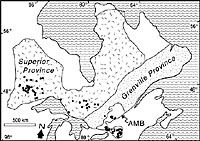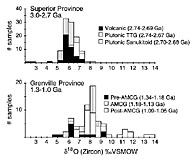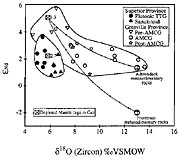Oxygen Isotope Perspective on Precambrian Crustal Growth and Maturation
Peck, William, H., King, Elizabeth M. and Valley, John W. (2000) Oxygen isotope perspective on Precambrian crustal growth and maturation. Geology; April 2000; v. 28; no. 4; p. 363-366.
Abstract
In this study, we contrast insights on Precambrian crustal growth and maturation from radiogenic and oxygen isotope systematics in the Superior (3.0-2.7 Ga) and Grenville (1.3-1.0 Ga) Provinces of the Canadian Shield. Oxygen isotope ratios in zircon provide the best evidence of supracrustal input into ancient orogens. Archean Superior Province zircons have relatively low d18O values and a limited range (5.7‰ ± 0.6‰), while Proterozoic Grenville Province zircons have elevated d18O values and a wider range (8.2‰ ± 1.7‰). These data reflect fundamental differences in crustal evolution and maturation between the Superior and the Grenville Provinces. In the Grenville Province, radiogenically juvenile supracrustal material with high d18O values was buried (or subducted) to the base of the crust within 150 Ma of initial crust production, causing high magmatic d18O values (d18O (zircon) ³ 8‰) in anorthosite-suite and subsequent plutons. Information about large volumes and rapid recycling of Grenville crust is not accessible from radiogenic isotope data alone. The Grenville data contrast with the restricted d18O values of Superior Province magmatism, where subtle (~1‰) elevation in d18O occurs only in volumetrically minor, late to postorogenic (sanukitoid) plutons. Differences in sediment d18O values between the Superior and Grenville Provinces are predominantly a function of the d18O of source materials, rather than differences in chemical maturity or erosion styles. This study shows that zircon is a robust reference mineral to compare igneous processes in rocks which have experienced radically different histories.
 |
 |
| Figure 1. The Superior and Grenville Provinces of the Canadian Shield; dots show sampling localities. AMB = Allochthonous Monocyclic Belt of Grenville Province. | Figure 2. Oxygen isotope ratios of zircons from the Superior and Grenville Provinces. Superior Province samples show a tight range of relatively low and primitive d18O values (5.7‰ ± 0.6‰). Grenville Province samples are more evolved and have higher average d18O (indicating substantial supracrustal input) as well as a larger range in oxygen isotope ratios (8.2‰ ± 1.7‰). TTG= Tonalite-Trondhjemite-Granodiorite; AMCG= anorthosite-mangerite-charnockite-granite suite; VSMOW = Vienna standard mean ocean water. |
